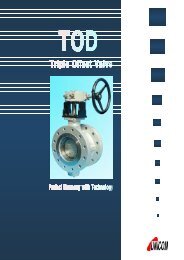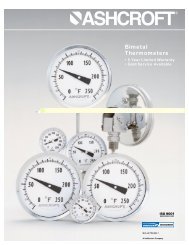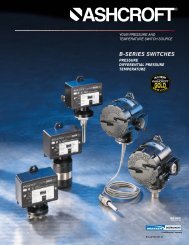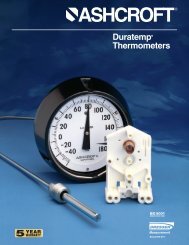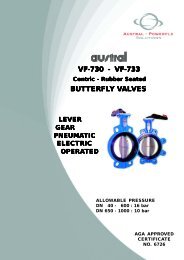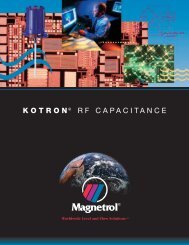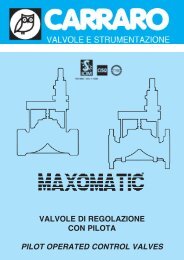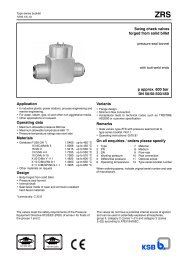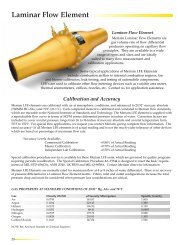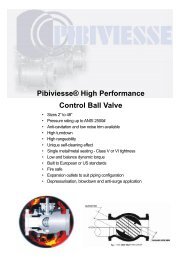Pressure Switches L&G Bulletin.pdf - Pilgrim Instrument
Pressure Switches L&G Bulletin.pdf - Pilgrim Instrument
Pressure Switches L&G Bulletin.pdf - Pilgrim Instrument
You also want an ePaper? Increase the reach of your titles
YUMPU automatically turns print PDFs into web optimized ePapers that Google loves.
SWITCH SELECTION INFORMATION<br />
Enclosure<br />
Cover<br />
Cover Gasket<br />
Switching Element(s)<br />
Switching Function<br />
(Mechanism)<br />
Enclosure<br />
Piston Assembly<br />
Diaphragm<br />
O-Ring<br />
<strong>Pressure</strong><br />
Connection<br />
PRESSURE, TEMPERATURE AND<br />
DIFFERENTIAL PRESSURE SWITCH<br />
SELECTION<br />
Before making your selection, please consider<br />
the following:<br />
1. Actuator<br />
The actuator responds to changes in pressure,<br />
temperature or differential pressure and operates<br />
the switch element in response to these<br />
changes.<br />
The actuator is normally exposed to process<br />
fluid and must therefore be chemically compatible<br />
with it. The following may be used to<br />
help select actuator type:<br />
For nominal pressure ranges 0-15 psi through<br />
0-3000 psi, Dresser’s standard actuator is a<br />
diaphragm-sealed piston. In this actuator, process<br />
pressure acting on the piston causes it to<br />
overcome the adjustment spring force and actuate<br />
a snap-action switch. A diaphragm and<br />
O-ring seal the process media from this<br />
mechanism. These are available in Buna-N,<br />
Teflon and Viton. The standard process connection<br />
is stainless steel. Optional all-welded<br />
diaphragms and pressure connections are<br />
available in 316 SS and Monel.<br />
For "H 2<br />
0 <strong>Pressure</strong> and Differential <strong>Pressure</strong><br />
Ranges, a diaphragm actuator is used. In this<br />
design, the standard pressure connections are<br />
carbon steel. Diaphragms are available in<br />
Viton, Buna N and Teflon. Always review process<br />
temperature limits before making seal selections.<br />
Optional stainless steel pressure connections<br />
are available (option XTA).<br />
For High Differential <strong>Pressure</strong> Actuator<br />
Ranges, 3-15 to 60-600 psid, a dual diaphragm<br />
sealed piston actuator is used. This<br />
actuator is designed for high static-pressure<br />
applications. The standard pressure connections<br />
are nickel-plated brass. Diaphragms are<br />
available in Viton, Buna N and Teflon. Always<br />
review process temperature limits before making<br />
seal selections. Optional stainless steel<br />
pressure connections are available (option<br />
XUD).<br />
For all temperature ranges, the standard Ashcroft<br />
temperature actuator operates on the vapor<br />
pressure principle: The vapor pressure in a<br />
sealed thermal system is applied to a sensing<br />
element, which in turn actuates a switch. This<br />
is known as a SAMA Class II system. Various<br />
filling materials are used, including Propane,<br />
Butane, Methyl Alcohol, N Propyl Alcohol and<br />
Xylene. High overtemperature capability is<br />
possible with this type of system. The interface<br />
between liquid and vapor is the point at which<br />
sensing occurs. This is the “sensitive” portion<br />
of the bulb. Bulb extensions and capillary are<br />
normally filled with vapor and have little effect<br />
on the setpoint, regardless of ambient temperature<br />
variations; therefore, no ambient<br />
compensation is required. For best results, the<br />
bulb should be mounted within 60 degrees of<br />
vertical to assure the liquid remain in the bulb.<br />
2. Enclosure<br />
The enclosure protects the switch element and<br />
mechanism from the environment and has<br />
provisions for mounting and wiring. Ashcroft<br />
switch enclosures are epoxy-coated aluminum<br />
or stainless steel for maximum corrosion resistance.<br />
Choose between watertight NEMA 4,<br />
4X for most industrial applications and 316 SS<br />
for more corrosive environments.<br />
Ashcroft enclosures include watertight cover<br />
gaskets, external mounting holes and one or<br />
two 3/4 NPT electrical conduit holes for ease of<br />
installation. <strong>Pressure</strong> switches may also be<br />
mounted directly to the process by means of<br />
the standard 1/4 NPTF or optional 1/2 NPTM<br />
pressure connection.<br />
Note: When installing Ashcroft switches, refer<br />
to instruction sheets included with each switch,<br />
the National Electrical Code, and any other local<br />
codes or requirements to assure safety.<br />
3. The Switching Function<br />
Next, consider the switching function. Most<br />
applications for alarm and shutdown are satisfied<br />
by single setpoint, fixed deadband models.<br />
For high/low or alarm and shutdown, the dual<br />
setpoint models may be selected. For pump,<br />
compressor, level and other control applications,<br />
an adjustable deadband model is often<br />
the best choice.<br />
4. The Switch Element<br />
Finally, the electrical switching element must<br />
be compatible with the electrical load being<br />
switched. For ease of selection, all electrical<br />
switching elements are snap-acting, SPDT<br />
(single pole-double throw), or 2 (SPDT). Refer<br />
to catalog pages for switch element choices.<br />
Select a switch element with electrical rating<br />
that exceeds the electrical rating of the device<br />
being controlled by the switch. For better reliability<br />
and safety, optional hermetically sealed<br />
switching elements may be specified.<br />
8



